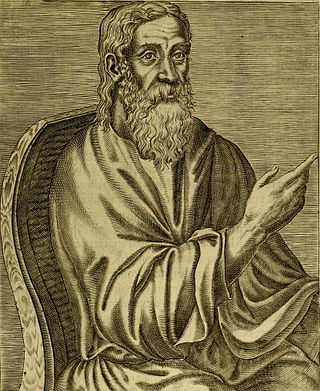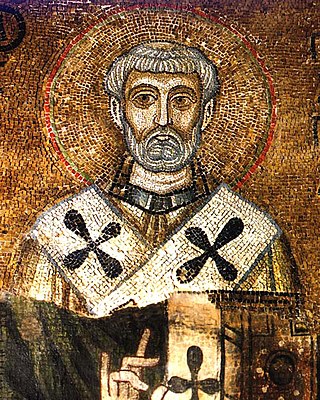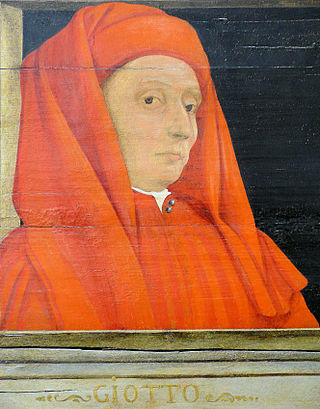
Titus Flavius Clemens, also known as Clement of Alexandria, was a Christian theologian and philosopher who taught at the Catechetical School of Alexandria. Among his pupils were Origen and Alexander of Jerusalem. A convert to Christianity, he was an educated man who was familiar with classical Greek philosophy and literature. As his three major works demonstrate, Clement was influenced by Hellenistic philosophy to a greater extent than any other Christian thinker of his time, and in particular, by Plato and the Stoics. His secret works, which exist only in fragments, suggest that he was familiar with pre-Christian Jewish esotericism and Gnosticism as well. In one of his works he argued that Greek philosophy had its origin among non-Greeks, claiming that both Plato and Pythagoras were taught by Egyptian scholars.

Pope Zachary was the bishop of Rome from 28 November 741 to his death. He was the last pope of the Byzantine Papacy. Zachary built the original church of Santa Maria sopra Minerva, forbade the traffic of slaves in Rome, negotiated peace with the Lombards, and sanctioned Pepin the Short's usurpation of the Frankish throne from Childeric III. Zachary is regarded as a capable administrator and a skillful and subtle diplomat in a dangerous time.

Clement of Rome, also known as Pope Clement I, was the bishop of Rome in the late first century AD. He is listed by Irenaeus and Tertullian as the bishop of Rome, holding office from 88 AD to his death in 99 AD. He is considered to be the first Apostolic Father of the Church, one of the three chief ones together with Polycarp and Ignatius of Antioch.

Noah's Ark is the ship in the Genesis flood narrative through which God spares Noah, his family, and examples of all the world's animals from a global deluge. The story in Genesis is based on earlier flood myths originating in Mesopotamia, and is repeated, with variations, in the Quran, where the Ark appears as Safinat Nūḥ and al-fulk. The myth of the global flood that destroys all life begins to appear in the Old Babylonian Empire period. The version closest to the biblical story of Noah, as well as its most likely source, is that of Utnapishtim in the Epic of Gilgamesh.

Cesare Baronio, C.O. was an Italian Oratorian, cardinal and historian of the Catholic Church. His best-known works are his Annales Ecclesiastici, which appeared in 12 folio volumes (1588–1607). He is under consideration for sainthood and, in 1845, Pope Benedict XIV declared him Venerable.

A barque, barc, or bark is a type of sailing vessel with three or more masts and mainmasts rigged square and only the mizzen rigged fore and aft. Sometimes, the mizzen is only partly fore-and-aft rigged, bearing a square-rigged sail above.

Philip Romolo Neri, known as the "Second Apostle of Rome", after Saint Peter, was an Italian priest noted for founding a society of secular clergy called the Congregation of the Oratory.
Pope Donus was the bishop of Rome from 676 to his death. Few details survive about him or his achievements beyond what is recorded in the Liber Pontificalis.

The primacy of Peter, also known as Petrine primacy, is the position of preeminence that is attributed to Peter among the Twelve Apostles.

The Minor Basilica of St. Mary in Domnica alla Navicella, or simply Santa Maria in Domnica or Santa Maria alla Navicella, is a Roman Catholic basilica in Rome, Italy, dedicated to the Blessed Virgin Mary and active in local charity according to its long tradition. It is one of the best examples of the so-called "Carolingian renaissance" in Rome. It has been the titular church of Cardinal Marcello Semeraro since 28 November 2020.

Old St. Peter's Basilica was the building that stood, from the 4th to 16th centuries, where St. Peter's Basilica stands today in Vatican City. Construction of the basilica, built over the historical site of the Circus of Nero, began during the reign of Emperor Constantine I. The name "old St. Peter's Basilica" has been used since the construction of the current basilica to distinguish the two buildings.
Constantino Cajetan was a Benedictine scholar.
John of Crema was an Italian papal legate and cardinal. He was a close supporter of Pope Callistus II.

"Hail, Queen of Heaven, the Ocean Star" is a Marian hymn written by Father John Lingard (1771–1851), a Catholic priest and historian who, through the works of William Cobbett, helped to smooth the passage of the Catholic Emancipation Act in England.
The historical roots of Papal primacy can be traced back to the early centuries of Christianity, wherein the bishop of Rome, commonly referred to as the Pope, gradually accrued increasing authority and recognition. A confluence of historical, theological, and political factors contributed to this development.

St. George's Syro-Malabar Forane Church, locally known as Edapally Church is a Catholic pilgrimage church in Edapally, Kochi, India. It is considered as Asia's largest shrine dedicated to Saint George, about five million people visit it every year.

The Stefaneschi Altarpiece is a triptych by the Italian painter Giotto, from c. 1320. It was commissioned by Cardinal Giacomo Gaetani Stefaneschi to serve as an altarpiece for one of the altars of Old St. Peter's Basilica in Rome. It is now at the Pinacoteca Vaticana, in Rome.

Giotto di Bondone, known mononymously as Giotto and Latinised as Giottus, was an Italian painter and architect from Florence during the Late Middle Ages. He worked during the Gothic and Proto-Renaissance period. Giotto's contemporary, the banker and chronicler Giovanni Villani, wrote that Giotto was "the most sovereign master of painting in his time, who drew all his figures and their postures according to nature" and of his publicly recognized "talent and excellence". Giorgio Vasari described Giotto as making a decisive break from the prevalent Byzantine style and as initiating "the great art of painting as we know it today, introducing the technique of drawing accurately from life, which had been neglected for more than two hundred years".
The spirits in prison is a recurrent minor subject in the writings of Christianity.

The Navicella or Bark of St. Peter, of Old Saint Peter's Basilica in Rome, was a large and famous mosaic by Giotto di Bondone that occupied a large part of the wall above the entrance arcade, facing the main facade of the basilica across the courtyard. It depicted the version from the Gospel of Matthew of Christ walking on the water, the only one of the three gospel accounts where Saint Peter is summoned to join him. It was almost entirely destroyed during the construction of the new Saint Peter's Basilica in the 17th century, but fragments were preserved from the sides of the composition, and what is effectively a new work, incorporating some original fragments, was restored to a position at the centre of the portico of the new building in 1675.

















